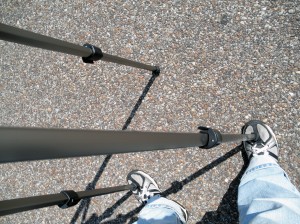The past weekend, I covered an environmental protest at the White House. Activists were holding the first in a series of sit-ins to protest a proposed oil pipeline and were arrested for violating sidewalk traffic laws.
I covered the event with live updates from the scene throughout the day, as well as a preview story and final story recapping everything for the next day. I also did two videos, one for the same client and one for another client. It was a crazy weekend, especially with the videos, but a good experience doing something normally outside my comfort zone.
Covering a protest or rally is something everyone reporting in Washington should do for the experience of working under a tight deadline, and a good way to get your final requirements for Medill out of the way – if you can handle the pressure and manage your time well.
Here are some tips to a successful reporting experience.

Environmentalists plan to protest against the Keystone XL pipeline every day from Aug. 20 through Sept. 3. (Alexandra Arkin / MNS)
Before the Event: What to bring
If you plan to do a written piece as well as multimedia, you not only have a lot of work ahead of you, but you have a heavy load to carry. In my case, I had to have my computer, video camera, still camera, tripod, notebook and pen, and extra video camera battery and tape. I had to pack as lightly and compactly as possible. At the same time, there were necessities that I had to bring, adding to the load and yet vital to a successful day:
• Hooded sweatshirt – It sounds ridiculous on a 90-degree day. But if you need to pull out your computer to start writing outside, the sun will create too much of a glare on your screen for you to see anything. A sweatshirt serves two purposes. If you drape it over your head and hook it over your computer screen like a tent, it creates shade for you to see your screen, and a space for a breeze to flow through.
• Comfortable shoes
• Sunscreen – Groups larger than 25 or people carrying signs must keep moving along the sidewalk, in order to keep it open for tourists and maintain the scenic value of the area and the White House. So as the protest began, police barricaded the sidewalk in front of the White House where the activists were protesting, and shepherded all the reporters into a pen created by other barricades, where we were forced to stand all afternoon. When I realized I would not be able to leave the pen for the afternoon because the police would not let me back in, I was thankful I had brought a small bottle of sunscreen.
• Food and water – It will be a long day. Food is good to have, if you can spare the room in your bag. I recommend fresh fruit, which has both water and a jolt of sugar. Water, however, is required.
Do your homework
You will not fully appreciate how chaotic a protest – even an organized sit-in – is until you are there and trying to lasso people for interviews in the few minutes before it begins.
Create a plan. Consider:
• Whom do you want to interview before the protest or event starts? What questions do you want to ask?
• What footage do you need to get?
• How early do you need to arrive to get the interviews and footage you need?
• Where is the nearest coffee shop for you to get Internet access?
• What are the rules about shooting video? Permits are required to shoot video using tripods at national monuments and parks. This means that you may not use a tripod on the White House sidewalk or across the street in Lafayette Park, but you may use it on Pennsylvania Avenue itself. Therefore, when you arrive, allow time to get the footage you are allowed to take with a tripod, in case you are restricted later in where you can go.
While there

I managed to get around the prohibition of tripods by "becoming one with the tripod." (Alexandra Arkin / MNS)
Police do enforce the prohibition of tripods, but there are ways to deal with not being able to use a tripod. You can use your body as a tripod, but your hands still sometimes shake. Another substitute for a tripod is putting your elbows on a police barricade and propping your arms and the camera up – as long as people are not bumping it causing the camera to shake. I also used two methods to create a “monopod.” First, I collapsed the legs of the tripod so it was one long pole. The second method involved putting two legs of the tripod on top of my feet and left the third leg on the ground. Note: I was not specifically told to stop when I resorted to either of these shooting techniques.
In the crush of people trying to get interviews or footage and sound bites, do whatever it takes to get your footage. Push your way to the front – especially if you are vertically challenged like me. Shoot between people’s legs, and under people’s arms if their arms are akimbo.
Finally, assume that you won’t be able to leave the site because of the police penning you up in the barricades. Once you are inside the barricades, if you have a chance, get down to work and start writing to save time later.
